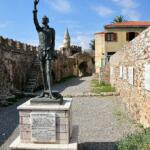About the Battle of Lepanto:
October 7, 1751 a battle at sea helped to shape the future of Europe. At this time in history, the Ottoman Empire had swept across most of the Mediterranean. In 1571, the Turks conquered Cyprus and that finally provoked action by Pope Pius V, who formed the Holy League, under Don Juan of Austria. The naval forces were drawn from among Christian nations at the time to defend Christendom against what seemed to be the invincible Ottoman Empire.
Pope Pius V ordered that all of Christendom pray the Rosary to stop the Islam forces that day. On board the ships of the Holy League, Mass was celebrated and the soldiers knelt to pray the Rosary before engaging the fresh forces of Islam.
A fleet of over 200 galleys proceeded to the Gulf of Lepanto (now Naupactos), near the city of Nafpaktos, where they met the Turkish fleet on October 7, 1571. The galleys were mainly from Venice (the main sea power in the Eastern Mediterranean) as well as Spain, but included squadrons from the Papal States and Genoa.
Our Lady of Guadalupe and the Battle of Lepanto:
The Archbishop of Mexico had an exact copy of Our Lady of Guadalupe that was sent to King Philip II, who in turn gave it to Andrea Doria, one of the three principal admirals of the fleet, who placed it in his cabin.
When the Armada went from file to line abreast and attacked on the morning of OCTOBER 7, 1571 the blue standard of Our Lady of Guadalupe was also flying from the masthead of Don Juan’s flagship.
The Victory of the Christian forces at Lepanto:
The result of the battle was an overwhelming victory for the Christian fleet: the Christians captured 117 galleys and 20 galliots (half-galleys), and sunk or destroyed some 50 other ships. Around 10,000 Turks were taken prisoner, and many thousands of Christian slaves were rescued. In the lopsided victory, the Christians suffered around 7,500 deaths, the Turkish side about 30,000.
This marked the end of Turkish expansion in the Mediterranean, which had threatened to wipe out Christianity in favor of Islam. (Note: the reconquista of Spain had already resulted in the expulsion of the Moors from the Iberian peninsula).
You can find a Youtube video that describes the battle here.
For a more detailed description of the battle read this article from the Royal Museums Greenwich.
About Nafpaktos, Greece:
Today, Nafpaktos is a picturesque town that one would not necessarily associate with a major sea battle.
But there are two memorials here to commemorate the Battle of Lepanto:

A statue of Miguel de Cervantes, the author of Don Quixote, who fought in the battle of Lepanto. At age 23, he had come down with a fever but reused to stay below and instead took part in the battle, during which he received three gunshot wounds: two in the chest and one in his left arm, which paralyzed and was cut off. Cervantes used to say that he lost his left hand so that he could glorify his right hand, making, of course, a reference to his literary work. Many of his military experiences are recorded in Don Quixote.
. The inscription above the statue says Miguel de Cervantes Saavedra (1547-1616), a Spanish soldier, a genius of letters, honor of humanity, wounded heroically at the naval battle of Nafpaktos.
There is also a plaque commemorating the battle.
Pope Pius V dedicated the day as one of thanksgiving to Our Lady of Victory.
Pope Gregory XIII later changed the name to the feast of Our Lady of the Rosary. We celebrate the Feast of Our Lady of the Rosary on October 7.

